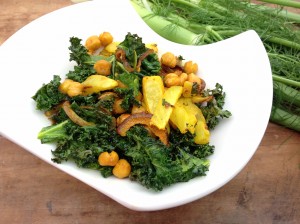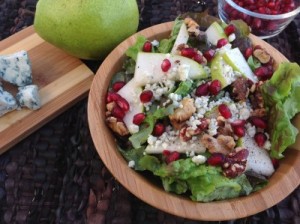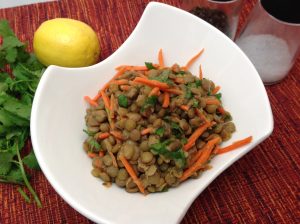 What is the best salad you have ever eaten?
What is the best salad you have ever eaten?
Take a second to think about it.
You may be thinking of a summer salad with fresh, in-season tomatoes, cucumbers, romaine lettuce, basil and other summer produce. Or maybe it’s a salad with juicy, flavorful strawberries, blueberries or watermelon that comes to mind.
Of course, summer is a wonderful season for flavorful salads that will also help keep you cool on those blistering hot days. But, delicious salads don’t have to end when the summer produce winds down. There is a huge universe of salads that are perfect to enjoy during the winter. By sticking with the theme of in-season ingredients, you can use cool-season greens, roasted vegetables, citrus and other fruits, whole grains and more to produce salads that are over-the-top in flavor, help provide comfort and warmth and will have your family and friends screaming for more!
Consider the possibilities!
 For your greens, focus on dark greens such as spinach, kale, swiss chard and arugula. These greens are absolutely loaded with nutrients to keep you healthy throughout the winter, plus they are sturdy enough to hold up well in salads that use warm ingredients such as roasted vegetables or cooked grains.
For your greens, focus on dark greens such as spinach, kale, swiss chard and arugula. These greens are absolutely loaded with nutrients to keep you healthy throughout the winter, plus they are sturdy enough to hold up well in salads that use warm ingredients such as roasted vegetables or cooked grains.
Fennel (such as in this Roasted Fennel, Chickpeas and Kale), cabbage, endive and radicchio are also fantastic additions to your winter salads.
 Savor roasted in-season vegetables. Winter vegetables, including root vegetables, are ideal to roast and add to winter salads. Roasting adds amazing flavor and texture to a wide variety of winter veggies including beets, sweet potatoes, carrots, turnips, winter squash, cauliflower, broccoli and Brussels sprouts.
Savor roasted in-season vegetables. Winter vegetables, including root vegetables, are ideal to roast and add to winter salads. Roasting adds amazing flavor and texture to a wide variety of winter veggies including beets, sweet potatoes, carrots, turnips, winter squash, cauliflower, broccoli and Brussels sprouts.
It really is as simple as cutting the vegetables into bite sized pieces, tossing them with a little olive oil, salt and pepper, and then roasting them in the oven for 20-30 minutes at 400 degrees. Trust us, if you are not already in the habit of roasting vegetables, try it and it might just change your life! Then, any variety of roasted winter vegetables can be added to your salad, such as the Maple Roasted Acorn Squash and Quinoa Salad, and then served warm or at room temperature.
Add whole grains! One of the easiest ways to make a salad heartier, healthier, and more interesting is to add whole grains. Quinoa is an excellent choice, but there are so many other grains to choose from including barley, farro, bulgur, couscous, freekeh, wild rice and many more. To make it as convenient as possible, you can cook your grains ahead of time, and then it is super-simple to warm them up and add to your salad.
Consider fruit! We love adding fruit to our winter salads. They add a sweetness and can serve as a reminder that warmer weather isn’t too far away. Dried fruits like cranberries, apricots and raisins work well – if possible, try to find them without a lot of added sugars. Fresh fruits are also fantastic this time of year, especially apples, pears, oranges, lemons and pomegranates.
 The winter months are an especially great time to enjoy pomegranates. Since they have a short season – October through February – take advantage of them while you can! They are fantastic in this Pomegranate Pear Salad! If you are reluctant to buy a whole pomegranate because you have to get the seeds out, don’t be intimidated…check out this coaching tip to see how seeding it is so much easier than you think!
The winter months are an especially great time to enjoy pomegranates. Since they have a short season – October through February – take advantage of them while you can! They are fantastic in this Pomegranate Pear Salad! If you are reluctant to buy a whole pomegranate because you have to get the seeds out, don’t be intimidated…check out this coaching tip to see how seeding it is so much easier than you think!
Add flavor with fresh or dried herbs. You may not be rolling in fresh basil like you are in the summer, but herbs such as dill, rosemary or sage can add incredible flavor to your winter salads. Consider adding the herbs to your roasted vegetables that will top your salad or add them to your homemade dressing.
 Go nuts! Anytime of the year, but especially in the winter, we love adding a crunch to our salads, such as in the Kale Waldorf Salad, and nuts and seeds are an ideal way to do that. You can use any variety, and there are so many to choose from…walnuts, pecans, almonds, sunflower seeds, pepitas (pumpkin seeds) and pine nuts, just to name a few.
Go nuts! Anytime of the year, but especially in the winter, we love adding a crunch to our salads, such as in the Kale Waldorf Salad, and nuts and seeds are an ideal way to do that. You can use any variety, and there are so many to choose from…walnuts, pecans, almonds, sunflower seeds, pepitas (pumpkin seeds) and pine nuts, just to name a few.
For added flavor and a delicious crispy crunch, you can toast the nuts or seeds before adding them to your salad. Simply add the nuts or seeds to a small dry skillet over medium heat, and cook about 3 minutes, stirring frequently, until toasted and fragrant. Watch them closely…they can brown very quickly!
Homemade croutons! Another great way to add crunch, texture and flavor to your salad is to make your own croutons. You can use any variety of your favorite whole grain bread. We enjoy using breads from a locally-owned bakery. Slice or tear the bread into small pieces, toss with a little olive oil and other seasonings if desired, and bake at 400 degrees for 10-15 minutes, stirring a couple times during the baking process. Once they are nice and crispy, you can store them in an air-tight container for a week or more.
 Add some protein. Of course, you can add a meat protein, such as chicken, fish, or pork to your winter salad. Another great way to add protein is using beans or legumes. Getting in the habit of adding plant-based proteins to your salads is nutritionally beneficial any time of year! We love using chickpeas, black beans, or white beans and, if you purchase the canned variety, all you need to do is rinse, drain and add to your salad — no cooking required! Lentils are also a fantastic addition to winter salads such as this Cilantro and Carrot Lentil Salad – just make sure not to overcook them or they will turn “mushy.”
Add some protein. Of course, you can add a meat protein, such as chicken, fish, or pork to your winter salad. Another great way to add protein is using beans or legumes. Getting in the habit of adding plant-based proteins to your salads is nutritionally beneficial any time of year! We love using chickpeas, black beans, or white beans and, if you purchase the canned variety, all you need to do is rinse, drain and add to your salad — no cooking required! Lentils are also a fantastic addition to winter salads such as this Cilantro and Carrot Lentil Salad – just make sure not to overcook them or they will turn “mushy.”
Cheese, please! Just not too much…a little cheese, even just 2 Tbsp, spread over a salad that serves 4, can add tremendous flavor to your salads. Experiment with different types of cheese, including varieties you may not have tried before.
A final tip, perhaps one of the most important ways to add the best flavor to your winter salads…make a homemade dressing. There are many winter-friendly salad dressings that are super-simple to make, but an ideal go-to anytime salad dressing is a simple combination of 2 to 3 Tbsp of olive oil and 1 Tbsp of balsamic vinegar. If you want to make it slightly creamy and tangy, add 1 Tbsp of dijon mustard. You can easily double or triple this if cooking for a crowd. During colder weather, a warm dressing can also provide a surprising comfort to your meal!
Enjoying a salad every day really can help keep you healthy through the winter, and using the right combinations of ingredients will keep them absolutely delicious!
What is your favorite winter salad?


Love these ideas for adding variety to salads and still keeping it simple!
Yeah, Violet! I agree. And look forward to sharing a salad with you after a workout again soon. 🙂